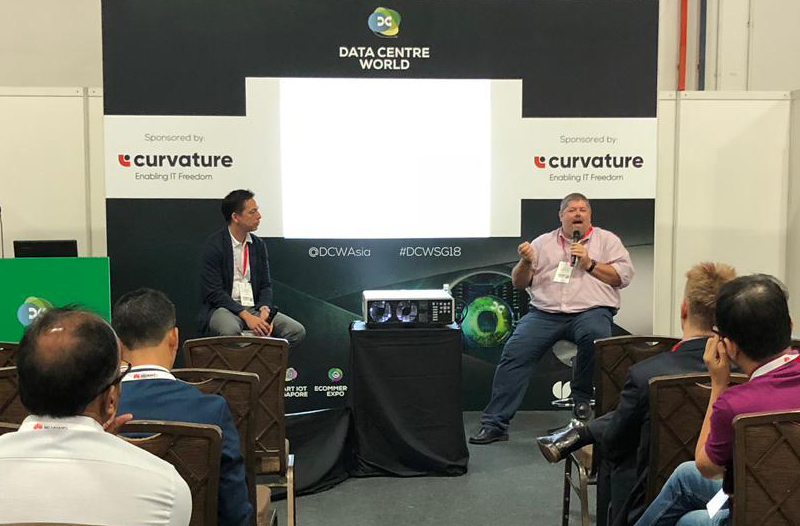In today’s age of innovation and hypercompetitive business climate, CIOs are often tasked to do more with less. They are also expected to better support the business with increased agility and flexibility in IT, while simultaneously balancing the technological needs of the organization.
For Bill Lichte, Executive Director and Head of IT for Southeast Asia at Nomura Securities, this means buying time for transition planning and staving off unnecessary tech refreshes upgrades – a position he found himself in three years ago.
Moving the needle with TPM
Joining Curvature’s Patrick Morris on stage at Cloud Expo Asia earlier this month, Lichte spoke about how Nomura Securities was able to avoid about US$40 million in capital expenditure and reduce his organisation’s Cisco SMARTnet expense by 60% with a third-party maintenance (TPM) strategy.

“All [Nomura Securities] really did was adopt a strategy called ‘Fit for Purpose.’ It essentially means basing technology refreshes on the end-user’s technical needs, and not necessarily on following OEM timetables,” explained Morris.
Morris noted that TPM has been adopted by many large enterprises and was the subject of various research notes and studies by analyst firms such as Gartner, Forrester and IDC. 1 Old practices die hard, however, and many enterprises are still planning their IT refresh around rigid OEM timetables.
“When I speak to a lot of enterprises, I’m still quite surprised to find that most enterprises today, to a large degree, still manage their IT refresh cycle predominately on an OEM’s EOL timelines. Sometimes it makes sense, other times it tends to be somewhat arbitrary,” he said.
Beyond expectations
Lichte admitted that there was some initial trepidation that TPM will not work out, and that the benefits determined from Curvature’s appraisal would not be compelling enough to make a difference. The anxiety proved unfounded, as the numbers that Curvature came back with turned out to be highly compelling.
“Even if the savings were a third or two-thirds of what [Curvature] indicated, we’ll still be saving money in the long run. And at the end of the day, considering that we were under pressure about IT spending, those cost savings [meant everything],” said Lichte.
So how has the situation been since Nomura Securities went with TPM? In this case, no news was good news. He noted: “Nothing has been brought up in the operational space, and they were the biggest naysayers when the project was first broached. It has been a very smooth journey since.”
Indeed, Lichte shared how the head of network operations would tell him every year how grateful he was with TPM, due to the significant cost reduction in maintenance costs that were redirected towards improving other aspects of the network. It wasn’t all smooth sailing of course, and Lichte conceded that getting global buy-in proved to be the most challenging aspect of the transition.
“The first 6 months of our relationship was trying to get this up and moving ahead. The difficult part was doing the analytical work, convincing people that this was the right thing to do and making sure that it fits your organizational strategy. Once you do that, and you make the decision, the process was very straightforward,” he said.
Establishing what works
One of the biggest misconceptions about TPM revolve around the misconception that it is only suitable for equipment that is EOL, or end-of-life, says Morris. This typically stems from concerns over lack of software support, and is a point often emphasized by OEMs to deter customers who were revaluating their maintenance contracts.
This isn’t true, says Morris, who used a popular Cisco switch to illustrate how software updates stopped four years ago. And this is true of a lot more equipment that large enterprises are not necessarily aware of, he says. “As a TPM provider, [its true] we can’t touch the code. But once the OEM stops publishing the software update, that’s the day where TPM becomes a really good fit.”
“If you look at [suitability for TPM] based on the EOL date, maybe you are talking only five or 10 percent of your IT infrastructure. But once you move the demarcation line for TPM from EOL to EoSW (End of SW Maintenance), three or four years earlier, now about 40 to 60 percent of your estate is a great fit for TPM. This transforms the entire situation,” said Morris.
The other challenge stems from understanding what constitutes a good fit, and is an aspect that a mature TPM provider will be well-equipped to help. In this case, Curvature’s ClearView assessment looked at data such as part numbers, stage within its asset lifecycle, and availability of SW updates to determine its maintenance and support status.
“In this case, we ran that assessment and we gave it back to Nomura Securities, and that allowed them to get a view of exactly what can be moved over,” said Morris. “We can quantify the savings based on what you would have spent on the refresh, what you didn’t spend, what you were spending on Cisco SMARTnet, what you’re spending today on that maintenance.”
And aside from cost savings, enterprises also gain in IT agility: “Now you’ve talked about software-defined networking (SDN), white boxes, and moving more workloads into the cloud. If you’re not in a situation where you are ready to make those decisions today, buying an extra year, two or three years give you IT agility.” The combination of cost savings and IT agility are two key business outcomes an enterprise can easily achieve through a hybrid OEM-TPM support model.
1. Gartner, Market Guide for Data Center and Network Third-Party Hardware Maintenance, Christine Tenneson, 09 August 2017; Gartner, Lower Both Storage Acquisition and Ownership Costs by Using Third-Party Maintenance, Stanley Zaffos, March 3, 2017; Gartner, How to Avoid the Biggest Rip-Off in Networking, Andrew Lerner & Sanjit Ganguli, 03 August 2017; IDC, Cut Operational Costs: Third-Party Maintainers for Legacy and Stable Datacenter Environments to Help Invest for the Future, Rob Brothers, June 2016.



